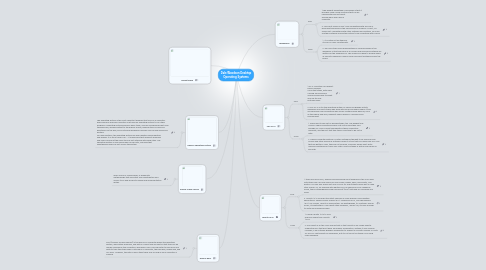
1. Define: Open Source
1.1. open source is a philosophy, or pragmatic methodology that promotes free redistribution and access to an end product's design and implementation details
2. Define: Operating System
2.1. The operating system is the most important program that runs on a computer. Every general-purpose computer must have an operating system to run other programs. Operating systems perform basic tasks, such as recognizing input from the keyboard, sending output to the display screen, keeping track of files and directories on the disk, and controlling peripheral devices such as disk drives and printers. For large systems, the operating system has even greater responsibilities and powers. It is like a traffic cop -- it makes sure that different programs and users running at the same time do not interfere with each other. The operating system is also responsible for security, ensuring that unauthorized users do not access the system.
3. Define: RAM
3.1. RAM (random access memory) is the place in a computer where the operating system, application programs, and data in current use are kept so that they can be quickly reached by the computer's processor. RAM is much faster to read from and write to than the other kinds of storage in a computer, the hard disk, floppy disk, and CD-ROM. However, the data in RAM stays there only as long as your computer is running.
4. Ubuntu 12.10
4.1. Pros
4.1.1. 1. there are more "lens," special purpose search result windows in the HUD dash. With them you can now search for your songs, videos, apps, documents, and photos. You can also search not only on your PC and network drives but on Web sites as well. So, for example with photos you can search for your images by name, tag or Exchangeable image file format (EXIF) data and on Facebook and Flickr.
4.1.2. 2. Ubuntu 12.10 includes the latest versions of many popular Linux desktop applications. These include: Firefox 16.01; LibreOffice 3.6.2, and Thunderbird 16.01. For movies, Ubuntu is using Totem; for photography, it's Shotwell; and for music, it's Rhythmbox. If you want other programs, I know I do, it's easy enough to install your preferred apps.
4.2. Cons
4.2.1. 1. Found Ubuntu 12.10 to look and feel slower than Ubuntu 12.04.
4.2.2. 2. One result of all this "live" Web activity is that Ubuntu is no longer directly supporting PCs that don't have 3D graphic acceleration. Instead, it uses Gallium llvmpipe, a 3D software graphics accelerator to support a common version of Unity for all PCs. That's great for developers, but it's not so hot for those of us using older hardware.
5. Market Share
6. Mac OS X
6.1. Pros
6.1.1. 1.OS X Mountain Lion doesn’t have a learning curve that steep, with users coming from previous versions being able to adapt and use its new features easily.
6.1.2. 2. Mac OS X is still the operating system of choice for graphic artists, designers and most others who work with visual and audio media. It also synchronizes user information well across multiple Apple devices, such as the iPhone and iPad, making it easily usable in a mobile office environment.
6.2. Cons
6.2.1. 1. Apple has its own set of disadvantages, too. The biggest one is price: Apple computers simply cost much more than your average PC. This is offset somewhat by those computers’ durability, and the fact that they take a long time to go out of date.
6.2.2. 2. Apple’s computer platform is often mistakenly thought to be immune from viruses and other malicious software. While it is true that you rarely hear of a Mac that has gotten a virus, they are not immune. Criminals simply don’t write malicious software for Macs very often. Don’t be taken in with a false sense of security!
7. Windows 8
7.1. Pros
7.1.1. 1.The biggest advantage of Windows is that it provides ready-made solutions that can be implemented by just about anyone who’s ever used a computer.
7.1.2. 2. Microsoft Office is also 100% compatible with any file or document produced in the office space in America. In fact, MS Office isn't compatible with other software and systems, so much as other software and systems strive to be compatible with Office.
7.2. Cons
7.2.1. 1. It is often not as stable as its Mac or Linux counterparts.
7.2.2. 2. The only other major disadvantage of using Windows in the workplace is that over 95% of all viruses and malicious software are written for the Windows OS. This means you have to double-down all security measures if you’re using Microsoft software across the board
